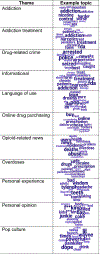Opioid Discussion in the Twittersphere
- PMID: 29659320
- PMCID: PMC6314840
- DOI: 10.1080/10826084.2018.1458319
Opioid Discussion in the Twittersphere
Abstract
Background: The rise in opioid use and overdose has increased the importance of improving data collection methods for the purpose of targeting resources to high-need populations and responding rapidly to emerging trends.
Objective: To determine whether Twitter data could be used to identify geographic differences in opioid-related discussion and whether opioid topics were significantly correlated with opioid overdose death rate.
Methods: We filtered approximately 10 billion tweets for keywords related to opioids between July 2009 and October 2015. The content of the messages was summarized into 50 topics generated using Latent Dirchlet Allocation, a machine learning analytic tool. The correlation between topic distribution and census region, census division, and opioid overdose death rate were quantified.
Results: We evaluated a tweet cohort of 84,023 tweets from 72,211 unique users across the US. Unique opioid-related topics were significantly correlated with different Census Bureau divisions and with opioid overdose death rates at the state and county level. Drug-related crime, language of use, and online drug purchasing emerged as themes in various Census Bureau divisions. Drug-related crime, opioid-related news, and pop culture themes were significantly correlated with county-level opioid overdose death rates, and online drug purchasing was significantly correlated with state-level opioid overdoses.
Conclusions: Regional differences in opioid-related topics reflect geographic variation in the content of Twitter discussion about opioids. Analysis of Twitter data also produced topics significantly correlated with opioid overdose death rates. Ongoing analysis of Twitter data could provide a means of identifying emerging trends related to opioids.
Keywords: Crime; opioids; overdose; social media; twitter.
Figures


Similar articles
-
Machine Learning and Natural Language Processing for Geolocation-Centric Monitoring and Characterization of Opioid-Related Social Media Chatter.JAMA Netw Open. 2019 Nov 1;2(11):e1914672. doi: 10.1001/jamanetworkopen.2019.14672. JAMA Netw Open. 2019. PMID: 31693125 Free PMC article.
-
Epidemiology from Tweets: Estimating Misuse of Prescription Opioids in the USA from Social Media.J Med Toxicol. 2017 Dec;13(4):278-286. doi: 10.1007/s13181-017-0625-5. Epub 2017 Aug 22. J Med Toxicol. 2017. PMID: 28831738 Free PMC article.
-
Exploring trends of nonmedical use of prescription drugs and polydrug abuse in the Twittersphere using unsupervised machine learning.Addict Behav. 2017 Feb;65:289-295. doi: 10.1016/j.addbeh.2016.08.019. Epub 2016 Aug 17. Addict Behav. 2017. PMID: 27568339
-
The Opioid Crisis and the Physician's Role in Contributing to its Resolution: Step One--Prevention of Overdoses.Conn Med. 2016 Jun-Jul;80(6):325-34. Conn Med. 2016. PMID: 27509638 Review.
-
The Opioid Epidemic: Moving Toward an Integrated, Holistic Analytical Response.J Anal Toxicol. 2019 Jan 1;43(1):1-9. doi: 10.1093/jat/bky049. J Anal Toxicol. 2019. PMID: 30165647 Review.
Cited by
-
Thematic Analysis of Reddit Content About Buprenorphine-naloxone Using Manual Annotation and Natural Language Processing Techniques.J Addict Med. 2022 Jul-Aug 01;16(4):454-460. doi: 10.1097/ADM.0000000000000940. Epub 2021 Dec 23. J Addict Med. 2022. PMID: 34864788 Free PMC article.
-
Using Twitter to Surveil the Opioid Epidemic in North Carolina: An Exploratory Study.JMIR Public Health Surveill. 2020 Jun 24;6(2):e17574. doi: 10.2196/17574. JMIR Public Health Surveill. 2020. PMID: 32469322 Free PMC article.
-
Social Media as a Research Tool (SMaaRT) for Risky Behavior Analytics: Methodological Review.JMIR Public Health Surveill. 2020 Nov 30;6(4):e21660. doi: 10.2196/21660. JMIR Public Health Surveill. 2020. PMID: 33252345 Free PMC article. Review.
-
Can accurate demographic information about people who use prescription medications nonmedically be derived from Twitter?Proc Natl Acad Sci U S A. 2023 Feb 21;120(8):e2207391120. doi: 10.1073/pnas.2207391120. Epub 2023 Feb 14. Proc Natl Acad Sci U S A. 2023. PMID: 36787355 Free PMC article.
-
Predicting U.S. county opioid poisoning mortality from multi-modal social media and psychological self-report data.Sci Rep. 2023 Jun 3;13(1):9027. doi: 10.1038/s41598-023-34468-2. Sci Rep. 2023. PMID: 37270657 Free PMC article.
References
-
- Association for Computational Linguistics. (2012, July 10). Proceeding of the system demonstrations. Retrieved from http://www.anthology.aclweb.org/P/P12/P12-3.pdf#page=37
-
- Beletsky L, Davis CS (2017). Today’s fentanyl crisis: Prohibition’s Iron Law, revisited. Int J Drug Policy, 46:156–159. - PubMed
-
- Blanco C, Alderson D, Ogburn E, et al. (2007). Changes in the prevalence of non-medical prescription drug use and drug use disorders in the United States: 1991–1992 and 2001–2002. Drug Alcohol Depend, 90(2–3):252–260. - PubMed
-
- Centers for Disease Control and Prevention. (2014). Opioid painkiller prescribing infographic . Retrieved from https://www.cdc.gov/vitalsigns/opioid-prescribing/infographic.html
Publication types
MeSH terms
Substances
Grants and funding
LinkOut - more resources
Full Text Sources
Other Literature Sources
Medical
